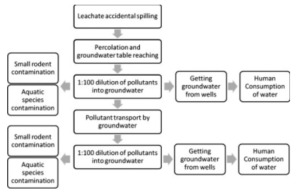Human Exposure to Bisphenol A from Landfill Leachate-Contaminated Water
By: Gwyn Chilcoat
Introduction
Landfills are the preeminent mechanism for waste disposal in much of the world. Landfills compare favorably to other waste disposal methods such as dumping or incineration from a public health perspective, but their human health implications still warrant concern. It is near-impossible to generalize about the health consequences of landfills because each one is unique, dependent on local production, consumption, and disposal choices. Leachate is a suspension of solids in liquid that forms as liquid from the waste and precipitation that falls on the landfill percolate through the waste; therefore, leachate composition is dependent upon landfill composition. Consequently, leachate is contaminated with landfill toxins such as heavy metals, pathogens, and toxic chemicals, including xenobiotic endocrine-disrupting compounds (EDCs) (Kjeldsen et al., 2002). EDCs harm human and environmental health by imitating hormones, thereby disrupting endocrine pathways. They are prevalent in landfills because many chemicals used in plastics, flame retardation, and a variety of industrial processes are estrogenic (National Institute of Environmental Health Sciences, 2020). This paper focuses on one of the most widespread EDCs in municipal solid waste (MSW) landfill leachate: bisphenol A (BPA). I will examine the pathway from landfill to drinking water contamination, the health effects of exposure, and the significance of BPA contamination.
Discussion
Pathway
Leachate collection systems that transport leachate for treatment at a wastewater treatment plant (WWTP) are increasingly common, but they are not ubiquitous, and collection systems must be regularly maintained to be effective (Ramke, 2018, Idowu, 2019). There are two main pathways by which untreated leachate can contaminate groundwater, both of which landfill design attempts to prevent (see Figure 1). First, leachate can escape through holes in the leachate-containing layers of the landfill and leach into groundwater (Szymanski et al., 2018). Second, precipitation may cause leachate runoff which can then leach into groundwater (Aziz, 2013). As a result, well water in the vicinity of landfills can be contaminated by leachate (Talalaj and Dzienis, 2006). BPA is known to contaminate water, and landfill leachate contamination is a hypothesized cause because it is present at high volumes in landfills and many products containing BPA are disposed of in landfills (Vandenberg et al., 2007). In 2008, Bertanza and Pedrazzini published a review on EDCs in landfill leachate and municipal wastewater. They state that “municipal sewage and municipal wastewater treatment effluents are considered to be a major source of [EDC] pollution,” which is troubling due to the significant human health implications of EDC pollution and the spottiness of leachate monitoring across the globe (Yang et al., 2008).

Figure 1. Hypothesized routes of exposure to landfill leachate (Baderna et al., 2018)
Human health concerns
Studying the health effects of EDCs is challenging because endocrine disruption has a broad array of physiological effects and because all humans are exposed to background levels of EDCs. Bisphenol A is a well-known endocrine disruptor that differs from others commonly found in landfill leachate, such as dioxins and biphenyls, in that it is still produced at high volumes. BPA is used in plastic and epoxy manufacturing, and humans are exposed to BPA from drinking out of water bottles and eating food out of cans contaminated with the substance (Baderna et al., 2011, Bauer, 2019). Although diet is considered to be the greatest source of BPA intake for humans, populations drinking landfill leachate-contaminated water may unknowingly consume far higher levels of BPA. Vandenberg et al. (2007) found over 150 studies of BPA exposure showing animal health impacts such as cancers and fertility problems at low dose exposure and that “many of these endpoints are in areas of current concern for human epidemiological trends.” Research is present on the health consequences of direct exposure to leachate and some routes of exposure to
BPA, but research on exposure to BPA from leachate-contaminated water is lacking. Scientists have calculated levels at which EDCs become harmful to human health and compared those to EDC concentration in landfill leachate and leachate-contaminated water, but have failed to directly link EDC exposure from landfills to health problems (Bertanza and Pedrazzini, 2008).
Significance
Measurements detecting BPA in landfill leachate began around 2000 and over the past few years has focused mainly on developing leachate treatments, suggesting that researchers find landfill leachate BPA exposure potentially harmful enough to expend resources to find solutions. It should be noted that although not the focus of this paper, BPA’s estrogenic properties harm environmental health (Bertanza and Pedrazzini, 2008, Baderna et al., 2011, Vandenberg, 2007). Studies on leachate composition from around the world usually detect BPA if they test for it, which is consistent with what is known about the prevalence and range of the substance. One study which collected data on dozens of leachate toxins at a landfill in Italy over the span of 11 years found BPA in 90% of sampling campaigns, a higher frequency than any other toxin studied (Baderna et al., 2011). Furthermore, there is evidence to suggest that BPA is the most significant EDC in landfill leachate: one study in Osaka North Port, Japan, showed that BPA accounted for 84% of estrogenic effects caused by leachate contamination of groundwater (Kawagoshi et al., 2013). However, because leachate composition is highly variable between different landfills, further research is required to validate or qualify those results on a broader scale.
Conclusions
BPA exposure via landfill leachate is concerning because research on contamination pathways suggests landfill leachate can contaminate drinking water, BPA is frequently cited as a leachate contaminant because it is produced at high volumes, and BPA consumption presents well-known threats to human health. However, no published research has determined whether leachate contamination results in BPA levels sufficiently high to cause human health consequences. Most existing research on the subject is very narrow in scope, examining only one or two steps of the pathway from BPA dumping to human exposure and health consequences. It is difficult to draw generalizations from such studies. Although BPA was the focus of this paper because it is reliably present in landfills and is a known toxin, other leachate-contaminating toxins–such as other EDCs, pathogens, and heavy metals–warrant further research because they are under-researched and present possible public health problems. No papers reviewed in this study were able to ascertain both drinking water contamination from leachate and an observable effect on human health in the affected community. I infer that this absence, rather than indicating that no such correlation exists, may be due to the difficulty of undertaking such large, interdisciplinary studies–and may be underscored by explicit and implicit discrimination against the marginalized communities that tend to live in these hazardous environments. A direct link between landfill-related BPA contamination and human health problems may be hard to quantify in part due to the diverse range of its potential health effects. I advise researchers to focus particularly on interdisciplinary research (i.e., collecting health data and sampling water in a community that is suspected to be exposed to leachate-contaminated drinking water) and on following possible exposure victims from prenatal development for decades in order to collect data on BPA levels in tissues and rates of illnesses known to be caused by BPA exposure compared to control populations.
References
- Aziz, SQ (2013). Produced Leachate from Erbil Landfill Site, Iraq: Characteristics, Anticipated Environmental Threats and Treatment, Conference: The 16th International Conference on Petroleum, Mineral Resources and Development.
- Baderna, D, Maggioni, S, Boriani, E, Gemma, S, Molteni, M, Lombardo, A, Colombo, A, Bordonali, S, Rotella, G, Lodi, M, & Benfenati, E (2011), A combined approach to investigate the toxicity of an industrial landfill’s leachate: chemical analyses, risk assessment and in vitro assays, Environmental Research, v. 111, p. 603–613.
- Baderna, D, et al. (2011). Composition of leachate: most recurrent compounds in 55 monitoring campaigns done in 11 years. Five campaigns were done yearly (one every 2 months excluding July and August). [Diagram]. Retrieved from https://doi.org/10.1016/j.envres.2011.01.015.
- Baderna, D, Caloni, F, Benfenati, E (2018), Investigating landfill leachate toxicity in vitro: A review of cell models and endpoints. Environment International, v. 122, p. 21-30. Bauer, BA (2019), What Is BPA, and What Are the Concerns about BPA?, Mayo Clinic, Mayo Foundation for Medical Education and Research, 18 Dec. 2019, www.mayoclinic.org/healthy-lifestyle/nutrition-and-healthy-eating/expert-answers/bpa/fa q-20058331.
- Bertanza, G, Pedrazzani, R (2008), Presence of EDCs (endocrine disrupting compounds) in landfill leachate and municipal wastewaters, M. Pawlowska, L. Pawlowski (Eds.), Management of Pollutant Emission from Landfills and Sludge, Taylor and Francis Group, London.
- Idowu, IA, Atherton, W, Hashim, K, Kot, P, Alkhaddar, R, Alo, B. I., & Shaw, A (2019), An analyses of the status of landfill classification systems in developing countries: Sub Saharan Africa landfill experiences, Waste Management, v. 87, p. 761-771. Kawagoshi, Y., Fujita, Y., Kishi, I., Fukunaga, I (2003), Estrogenic chemicals and estrogenic activity in leachate from municipal waste landfill determined by yeast two-hybrid assay, Environmental Monitoring and Assessment, v. 5 p. 269-274.
- Kjeldsen, P, Barlaz, MA, Rooker, AP, Baun, A, Ledin, A, Christensen, TH (2002), Present and long-term composition of MSW landfill leachate: A review, Critical Reviews in Environmental Science and Technology, v. 32, p. 297-336.
- National Institute of Environmental Health Sciences (2020), Endocrine Disruptors. Retrieved December 15, 2020 from https://www.niehs.nih.gov/health/topics/agents/endocrine/index.cfm
- Ramke, HG, (2018), Leachate collection systems. Solid Waste Landfilling: Concepts, Processes, Technology, 345.
- Szymański, K, Janowska, B, Iżewska, A, Sidełko, R, Siebielska, I (2018), Method of evaluating the impact of landfill leachate on groundwater quality, Environmental Monitoring and Assessment, v. 190.
- Talalaj, IA, Dzienis, L (2006), Influence of Leachate on Quality of Underground Waters, Polish Journal of Environmental Studies, v. 16, p. 139-144.
- Vandenberg, LN, Hauser, R, Marcus, M, Olea, N, Welshons, WV (2007), Human exposure to bisphenol A (BPA), Reproductive Toxicology, v. 24, p. 139-177.
- Yang, K, Zhou, XN, Yan, WA, Hang, DR, Steinmann, P (2008), Landfills in Jiangsu province, China, and potential threats for public health: leachate appraisal and spatial analysis using geographic information system and remote sensing, Waste Management, v. 28, p. 2750-2757.
